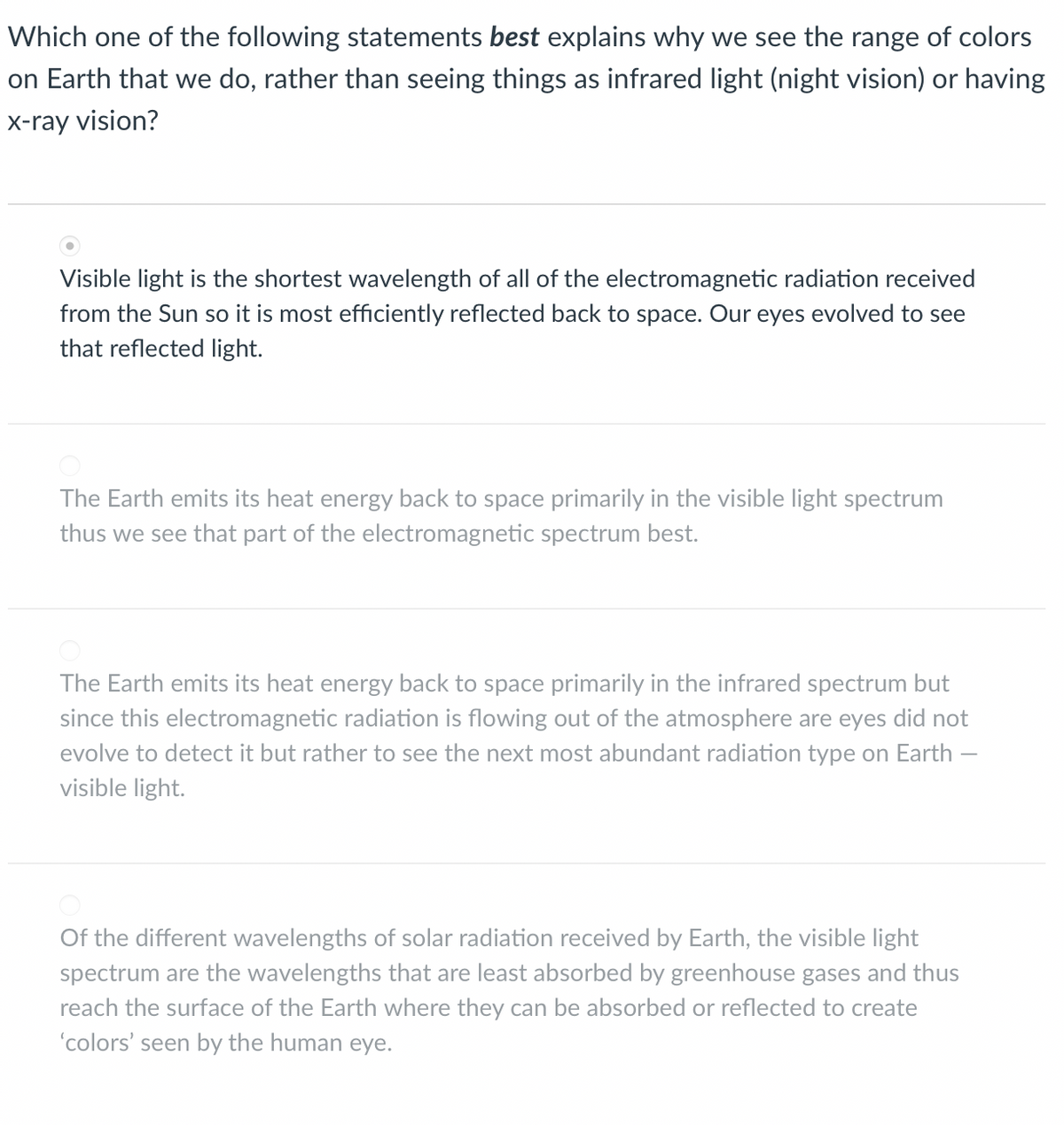Which one of the following statements best explains why we see the range of colors n Earth that we do, rather than seeing things as infrared light (night vision) or having -ray vision? Visible light is the shortest wavelength of all of the electromagnetic radiation received from the Sun so it is most efficiently reflected back to space. Our eyes evolved to see that reflected light.
Which one of the following statements best explains why we see the range of colors n Earth that we do, rather than seeing things as infrared light (night vision) or having -ray vision? Visible light is the shortest wavelength of all of the electromagnetic radiation received from the Sun so it is most efficiently reflected back to space. Our eyes evolved to see that reflected light.
Applications and Investigations in Earth Science (9th Edition)
9th Edition
ISBN:9780134746241
Author:Edward J. Tarbuck, Frederick K. Lutgens, Dennis G. Tasa
Publisher:Edward J. Tarbuck, Frederick K. Lutgens, Dennis G. Tasa
Chapter1: The Study Of Minerals
Section: Chapter Questions
Problem 1LR
Related questions
Question

Transcribed Image Text:Which one of the following statements best explains why we see the range of colors
on Earth that we do, rather than seeing things as infrared light (night vision) or having
x-ray vision?
Visible light is the shortest wavelength of all of the electromagnetic radiation received
from the Sun so it is most efficiently reflected back to space. Our eyes evolved to see
that reflected light.
The Earth emits its heat energy back to space primarily in the visible light spectrum
thus we see that part of the electromagnetic spectrum best.
The Earth emits its heat energy back to space primarily in the infrared spectrum but
since this electromagnetic radiation is flowing out of the atmosphere are eyes did not
evolve to detect it but rather to see the next most abundant radiation type on Earth -
visible light.
Of the different wavelengths of solar radiation received by Earth, the visible light
spectrum are the wavelengths that are least absorbed by greenhouse gases and thus
reach the surface of the Earth where they can be absorbed or reflected to create
'colors' seen by the human eye.
Expert Solution
This question has been solved!
Explore an expertly crafted, step-by-step solution for a thorough understanding of key concepts.
This is a popular solution!
Trending now
This is a popular solution!
Step by step
Solved in 2 steps

Recommended textbooks for you

Applications and Investigations in Earth Science …
Earth Science
ISBN:
9780134746241
Author:
Edward J. Tarbuck, Frederick K. Lutgens, Dennis G. Tasa
Publisher:
PEARSON

Exercises for Weather & Climate (9th Edition)
Earth Science
ISBN:
9780134041360
Author:
Greg Carbone
Publisher:
PEARSON

Environmental Science
Earth Science
ISBN:
9781260153125
Author:
William P Cunningham Prof., Mary Ann Cunningham Professor
Publisher:
McGraw-Hill Education

Applications and Investigations in Earth Science …
Earth Science
ISBN:
9780134746241
Author:
Edward J. Tarbuck, Frederick K. Lutgens, Dennis G. Tasa
Publisher:
PEARSON

Exercises for Weather & Climate (9th Edition)
Earth Science
ISBN:
9780134041360
Author:
Greg Carbone
Publisher:
PEARSON

Environmental Science
Earth Science
ISBN:
9781260153125
Author:
William P Cunningham Prof., Mary Ann Cunningham Professor
Publisher:
McGraw-Hill Education

Earth Science (15th Edition)
Earth Science
ISBN:
9780134543536
Author:
Edward J. Tarbuck, Frederick K. Lutgens, Dennis G. Tasa
Publisher:
PEARSON

Environmental Science (MindTap Course List)
Earth Science
ISBN:
9781337569613
Author:
G. Tyler Miller, Scott Spoolman
Publisher:
Cengage Learning

Physical Geology
Earth Science
ISBN:
9781259916823
Author:
Plummer, Charles C., CARLSON, Diane H., Hammersley, Lisa
Publisher:
Mcgraw-hill Education,